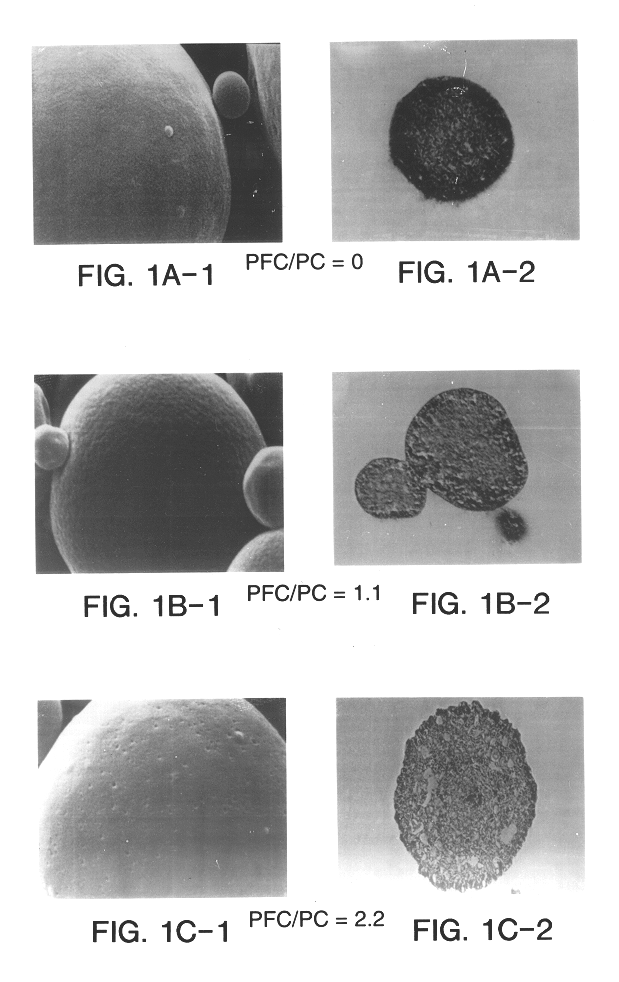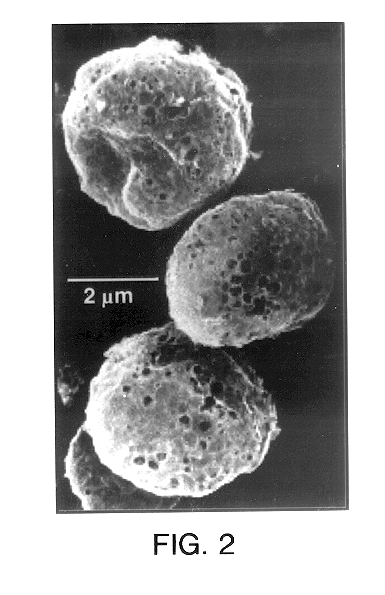Yet another associated
advantage of the present invention is the effective delivery of bioactive agents. As used herein, the terms "bioactive agent" refers to a substance which is used in connection with an application that is therapeutic or diagnostic in nature, such as methods for diagnosing the presence or absence of a
disease in a patient and / or methods for treating
disease in a patient. As to compatible bioactive agents, those skilled in the art will, appreciate that any therapeutic or
diagnostic agent may be incorporated in the stabilized dispersions of the present invention. For example, the bioactive agent may be selected from the group consisting of antiallergics, bronchodilators, bronchoconstrictors, pulmonary lung surfactants, analgesics,
antibiotics,
leukotriene inhibitors or antagonists, anticholinergics,
mast cell inhibitors, antihistamines, antiintlammatories, antineoplastics, anesthetics, anti-tuberculars, imaging agents, cardiovascular agents, enzymes, steroids, genetic material, viral vectors, antisense agents, proteins, peptides and combinations thereof. Particularly preferred bioactive agents comprise compounds which are to be administered systemically (i.e. to the
systemic circulation of a patient) such as peptides, proteins or polynucleotides. As will be disclosed in more detail below, the bioactive agent may be incorporated, blended in, coated on or otherwise associated with the perforated
microstructure.
is the effective delivery of bioactive agents. As used herein, the terms "bioactive agent" refers to a substance which is used in connection with an application that is therapeutic or diagnostic in nature, such as methods for diagnosing the presence or absence of a disease in a patient and / or methods for treating disease in a patient. As to compatible bioactive agents, those skilled in the art will, appreciate that any therapeutic or
diagnostic agent may be incorporated in the stabilized dispersions of the present invention. For example, the bioactive agent may be selected from the group consisting of antiallergics, bronchodilators, bronchoconstrictors, pulmonary lung surfactants, analgesics,
antibiotics,
leukotriene inhibitors or antagonists, anticholinergics,
mast cell inhibitors, antihistamines, antiintlammatories, antineoplastics, anesthetics, anti-tuberculars, imaging agents, cardiovascular agents, enzymes, steroids, genetic material, viral vectors, antisense agents, proteins, peptides and combinations thereof. Particularly preferred bioactive agents comprise compounds which are to be administered systemically (i.e. to the
systemic circulation of a patient) such as peptides, proteins or polynucleotides. As will be disclosed in more detail below, the bioactive agent may be incorporated, blended in, coated on or otherwise associated with the perforated
microstructure.
Accordingly, the present invention provides methods for the delivery of one or more bioactive agents comprising the steps of: providing a stabilized dispersion comprising a biocompatible suspension medium having dispersed therein a plurality of perforated microstructures wherein said perforated microstructures comprise a bioactive agent; and administering a therapeutically effective amount of said stabilized dispersion to at least a portion of the pulmonary passages of a patient in need thereof.
While the stabilized dispersions of the present invention are particularly suitable for the pulmonary administration of bioactive agents, they may also be used for the localized or
systemic administration of compounds to any location of the body. Accordingly, it should be emphasized that, in preferred embodiments, the formulations may be administered using a number of different routes including, but not limited to, the
gastrointestinal tract, the
respiratory tract, topically, intramuscularly, intraperitoneally, nasally, vaginally, rectally, aurally, orally or ocularly.
With respect to particulate dispersions, the selected bioactive agent, or agents, may be used as the sole
structural component of the perforated microstructures. Conversely, the perforated microstructures may comprise one or more components (i.e. structural materials, surfactants, excipients, etc.) in addition to the incorporated bioactive agents. In particularly preferred embodiments, the suspended perforated microstructures will comprise relatively high concentrations of surfactant (greater than about 10% w / w) along with the incorporated bioactive agent(s). Finally, it should be appreciated that the particulate or perforated
microstructure may be coated, linked or otherwise associated with the bioactive agent in a non-integral manner. Whatever configuration is selected, it will be appreciated that the associated bioactive agent may be used in its natural form, or as one or more salts known in the art.
The stabilized dispersions of the invention may optionally comprise one or more additives to further enhance stability or increase
biocompatibility. For example, various surfactants, co-solvents, osmotic agents, stabilizers, chelators, buffers,
viscosity modulators,
solubility modifiers and salts can be associated with the perforated microstructure, suspension medium, or both. The use of such additives will be understood to those of ordinary skill in the art and, the specific quantities, ratios, and types of agents can be determined empirically without undue experimentation.
 Login to View More
Login to View More 


